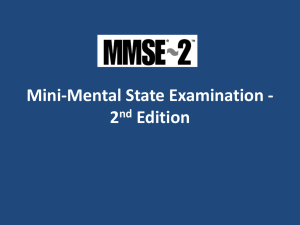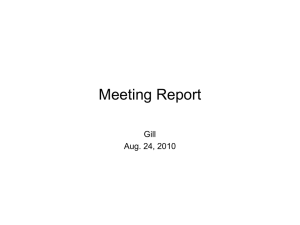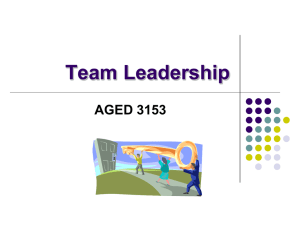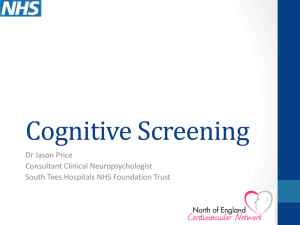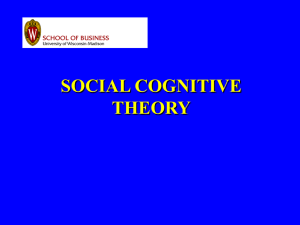Mental Status Examination: A Comprehensive Guide
advertisement
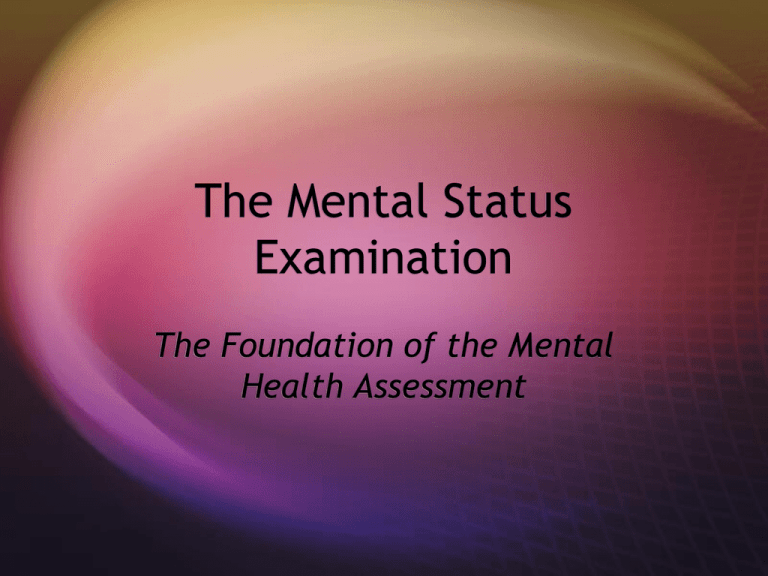
The Mental Status Examination The Foundation of the Mental Health Assessment Purpose Provides an estimate on the quality of client’s functioning Uses Estimate functioning to determine need for further testing Estimate functioning to determine treatment needs Assess progress when functioning has declined in an emergency situation Periodically assess insidious decline in functioning (e.g., dementias) Components Assesses general quality of: amnestic functions cognitive processing and intellectual functions form and content of thought nature, expression, and appropriateness of affect adaptive and maladaptive behaviors Symptoms of psychopathology What an MSE isn’t An intelligence test A detailed memory test A fully precise measure of cognition, affect, and behavior Prior to testing . . . Rapport - building is important in order to obtain the client’s cooperation and best effort in responding to the examination Ways to Conduct a MSE These components are assessed while interviewing the client about her concerns, circumstances, and history: Thought form and content Nature, expression, and appropriateness of affect Behavior strengths and weaknesses (or adaptive behaviors) Ways to Conduct a MSE These functions may be assessed informally during the interview, or formally through specific questions and tasks: Amnestic functions Cognitive processing and intellectual functions The Mini-Mental Status Examination A brief measure of amnestic and cognitive processing functions, used to assess short-term changes in mental functioning in hospitals assess changes in cognitive functioning in emergencies (e.g., injuries on the ball field) Assess progressive changes in cognitive functioning in long term care settings Obtain a “snapshot” of client’s functioning in outpatient mental health settings MMSE Original MMSE was the Mini - Mental State Examination (Folstein, Folstein, & McHugh, 1975) MMSE MMSE assesses: Orientation Short, recent, remote, remote memory Sustained concentration Executive functions Recognition Registration Sequencing and organization Comprehension Perceptual - motor skills Mental Status Scores Simple scoring system (point per item) Scores range from 0 - 30 Scores below 24 indicative of dementia or cognitive deficit Lower scores indicate greater deficits Scores obtained from small sample of Caucasian males and females from middle US Variations of MMSE Extended MMSE (John Ashford, M.D.,& Associates, 1992) St. Louis MMSE (1991) Solomon “7 Minute Screen” (2000) All these yield standardized scores Standardization samples are small and not broadly representative of national population Samples are not fully culture - fair Comprehensive Mental Status Examination These more fully assess cognitiveintellectual functions Include assessment of thought form and content, affect, and behaviors/symptoms Variations of MSEs Practitioners tend to develop their own versions of comprehensive mental status examinations As long as the protocol measures the areas typically assessed by these examinations, a wide range of specific items will serve the purposes Clinicians should avoid using IQ and memory test items in their MSEs Assessing Thought Form Thought form includes qualities of the way a person thinks and speaks Sample of problems in thought form, reflected in one’s speech: Circumstantial/tangential thought Pressured speech Flight of ideas Unusual vocal qualities (too loud, soft, trembling) Agnosia, aphasia, apraxia, echolalia, echopraxia Organizational/executive deficits Perseverative speech Assessing Thought Form Blocking Confusion/delirium Confabulation Poverty of speech Flat speech Content of Thought What are pervasive themes or ideas in client’s thoughts, such as: Hopeless thinking Helpless thinking Blaming/abdication of responsibility Negativistic thinking (Cleopatra Syndrome (queen of denial) Positive thoughts Content of Thought Content of thought assessment also includes: Hallucinations (visual, auditory [including command], various others) Delusions (reference, grandeur, persecution, jealousy, guilt, nihilistic, various others) Poverty of thought content Low thought complexity Assessment of Affect Range of affect: Restricted Dull Blunted versus flat labile Predominant Affect Describes the types of affect exhibited during interview, verbal and nonverbal Can exhibit more than one emotion during examination Appropriateness and Responsiveness Assess appropriateness of affect to topics discussed Is client responsive to encouragement? Levity? Behaviors and Symptoms Describe behaviors exhibited during the interview Assess dominant symptoms described by client, even if you don’t observe them See “Assessment Report” handout for representative symptoms If needed, survey adaptive behaviors The End www.iupui.edu/~flip/msenotes.htm “Ye got all that??”


